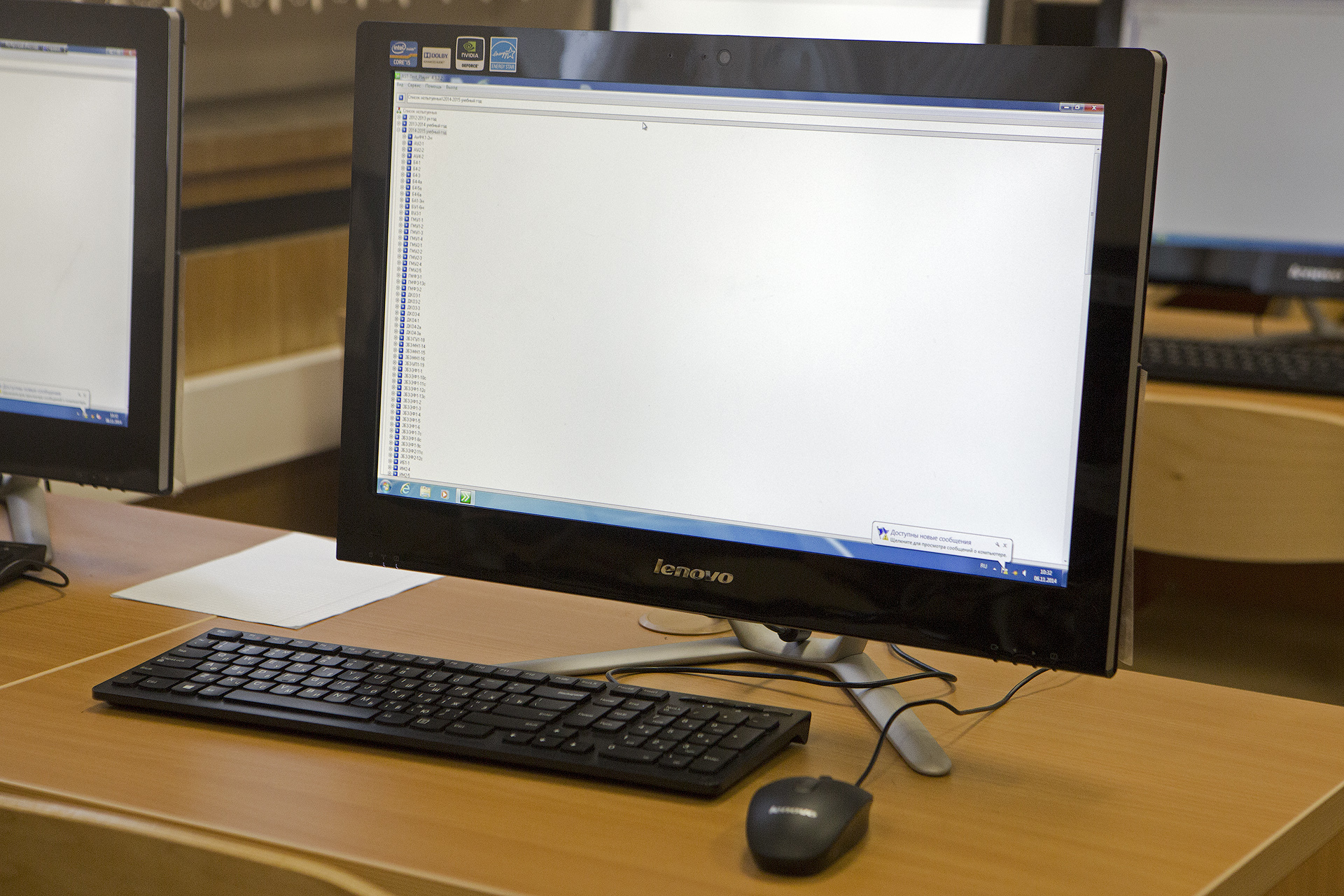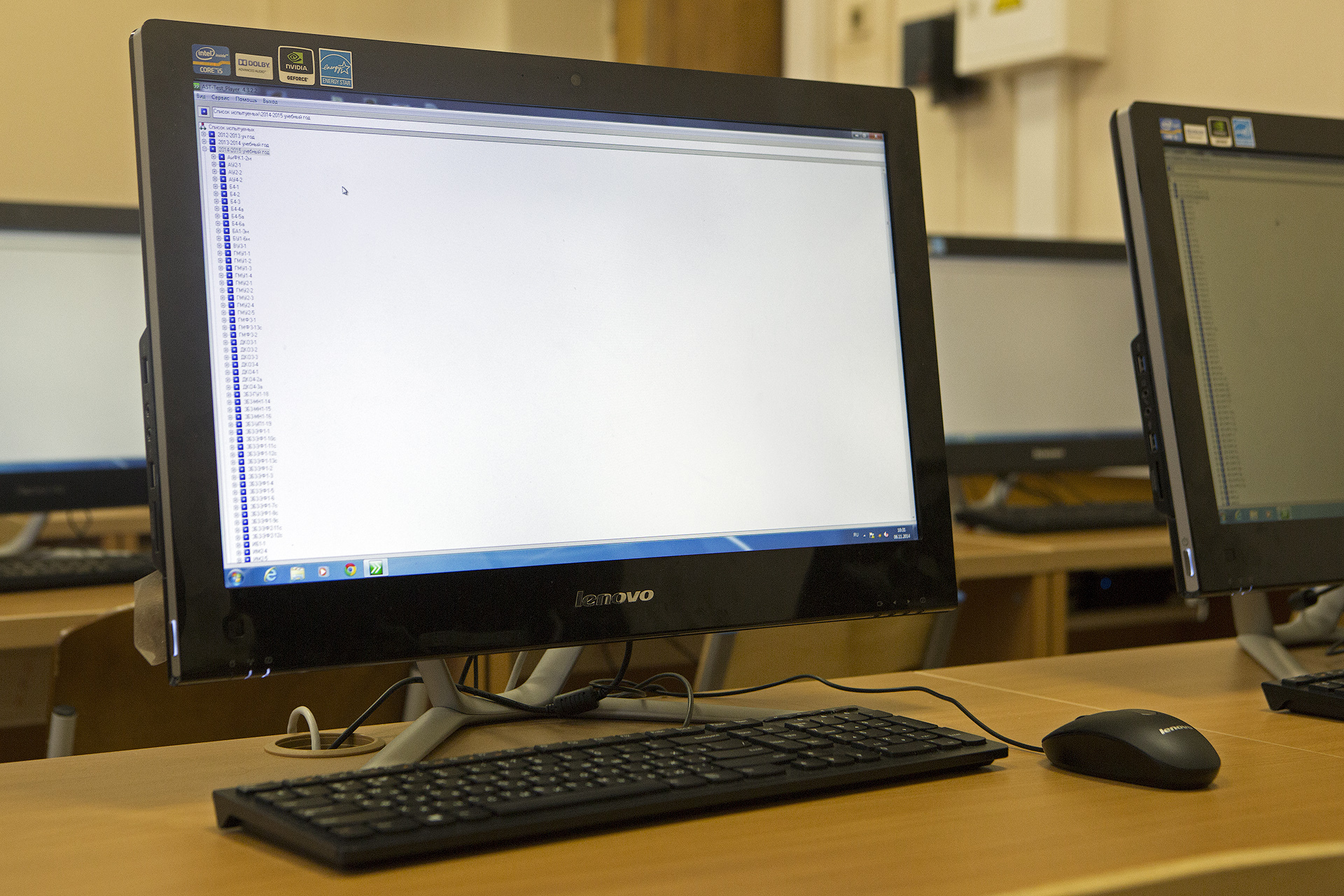Operation "Modernization": how to improve the learning process at the university with the help of monoblocks?
Do you remember your first computer class? Let's try to guess: almost certainly it was a fairly cramped room with a dense pile of desks in the middle and huge CRT monitors and massive “system loggers” placed on tables along three walls. And, of course, the teacher, who first with a strict view explains the new topic at the blackboard, then gives the command “through the machines!” And then runs from one student to another until the end of the lesson, selecting each mouse for explanations.
Unfortunately, the approach to learning in computer classes has not changed much since. But there are positive examples, and today we will talk about one of these. It is especially gratifying that this experience is Russian.

Everything happened at the Financial University under the Government of the Russian Federation . This is a large university with a rich history, originating in the distant 1919. Until recently, computer classes here were exactly the same as described at the very beginning of the material. Well, except that adjusted for the fact that CRT monitors have long been written off and replaced with liquid crystal. However, in 2012, the total number of students in an educational institution increased dramatically due to the addition of a number of other major universities. The numbers are serious: there were 18 thousand, and it became 90.
')
If we talk only about the Moscow campuses of the Financial University, then today the realities are as follows: 2080 computers in 80 computer classes.

Problem
Before the reorganization, the efficiency of computer audiences was low. The fact is that in one class it was impossible to accommodate more than 11-13 machines, since the rules of seating regulate the required amount of free space per student. It is not hard to guess that desktop computers have greatly restricted this space.
As a result, this arrangement required twice as many teachers as lectures in other disciplines. In addition, the teachers themselves spent most of the time on the running around between students' computers. One could only explain something to each one separately, or demonstrate the desktop of the teacher’s machine with the help of a projector and a screen.
Decision
In 2013, the Financial University launched a program to modernize computer classes. And for this we developed a comprehensive solution, and did not go through a simple "iron" upgrade.
All the old sets of “monitor + desktop” with the developed resource were written off, and relatively new machines were transferred to the administrative departments of the university. They should have been replaced by monoblocks that meet a number of basic requirements: affordable price, high reliability, a screen diagonal of 21 inches or more, a processor with a 3-5 years' performance margin, good after-sales support and the absence of unnecessary embedded components that will not be used , but at the same time affect the final cost.

These criteria met the computers of two brands - HP and Lenovo. According to the results of the tender, the Financial University purchased 350 Lenovo C440 monoblocks equipped with Intel Core i5 3330S processors, 4 GB RAM, a 1 TB hard disk and a 21.5-inch screen. Thus, if earlier, 11-13 desktops with monitors were placed in the same class, now exactly 26 Lenovo C330s are freely accommodated in the audience: 25 machines for students and one for the teacher. Plus, students do not need to sit around the perimeter of the class: they sit facing the blackboard right behind the computers, as in a normal classroom.

Also, LiteManager 4.5 was installed on all the machines, which allows the teacher to remotely control students' monoblocks, see their desktops, synchronize the clipboard, etc.

results
The results were not long in coming. First of all, the load on teachers was significantly reduced: exactly two times. Of course, some of them met modernization with bayonets. Largely due to the fact that it was required to master the new software for remote control of computers. However, in the end, everyone understood that in this way the learning process only becomes simpler and saves a lot of extra time in class. The teachers got used quickly enough, and now none of them admits the idea that it is possible to work in the old way.

In stationary computer labs, students now do not sit around the perimeter of the audience, but face the teacher. Walking the last in the class is completely excluded, because for the operational control of the assignment or just the usual assistance to an individual student, the LiteManager program’s capabilities are sufficient. And, of course, the teacher can demonstrate on the projector screen not only his desktop, but also the screen of any student computer.

Perspectives
At the moment, the approach has demonstrated its effectiveness. But Vladimir Soloviev, director of the Financial University of Information Technologies, is well aware that over time the need for traditional computer classes will gradually disappear. After all, now almost every student has several computers, including mobile ones, and tablets, smartphones and laptops are becoming more accessible every year.
Considering this factor, the Financial University assumes that the future is in VDI solutions, with the help of which students will be able to work with educational software configurations. The main thing is to give students using VDI technology access to university software from their personal devices. And, apparently, the process of mass introduction of such systems is not far off.

Unfortunately, the approach to learning in computer classes has not changed much since. But there are positive examples, and today we will talk about one of these. It is especially gratifying that this experience is Russian.

Everything happened at the Financial University under the Government of the Russian Federation . This is a large university with a rich history, originating in the distant 1919. Until recently, computer classes here were exactly the same as described at the very beginning of the material. Well, except that adjusted for the fact that CRT monitors have long been written off and replaced with liquid crystal. However, in 2012, the total number of students in an educational institution increased dramatically due to the addition of a number of other major universities. The numbers are serious: there were 18 thousand, and it became 90.
')
If we talk only about the Moscow campuses of the Financial University, then today the realities are as follows: 2080 computers in 80 computer classes.

Problem
Before the reorganization, the efficiency of computer audiences was low. The fact is that in one class it was impossible to accommodate more than 11-13 machines, since the rules of seating regulate the required amount of free space per student. It is not hard to guess that desktop computers have greatly restricted this space.
As a result, this arrangement required twice as many teachers as lectures in other disciplines. In addition, the teachers themselves spent most of the time on the running around between students' computers. One could only explain something to each one separately, or demonstrate the desktop of the teacher’s machine with the help of a projector and a screen.
Decision
In 2013, the Financial University launched a program to modernize computer classes. And for this we developed a comprehensive solution, and did not go through a simple "iron" upgrade.
All the old sets of “monitor + desktop” with the developed resource were written off, and relatively new machines were transferred to the administrative departments of the university. They should have been replaced by monoblocks that meet a number of basic requirements: affordable price, high reliability, a screen diagonal of 21 inches or more, a processor with a 3-5 years' performance margin, good after-sales support and the absence of unnecessary embedded components that will not be used , but at the same time affect the final cost.

These criteria met the computers of two brands - HP and Lenovo. According to the results of the tender, the Financial University purchased 350 Lenovo C440 monoblocks equipped with Intel Core i5 3330S processors, 4 GB RAM, a 1 TB hard disk and a 21.5-inch screen. Thus, if earlier, 11-13 desktops with monitors were placed in the same class, now exactly 26 Lenovo C330s are freely accommodated in the audience: 25 machines for students and one for the teacher. Plus, students do not need to sit around the perimeter of the class: they sit facing the blackboard right behind the computers, as in a normal classroom.

Also, LiteManager 4.5 was installed on all the machines, which allows the teacher to remotely control students' monoblocks, see their desktops, synchronize the clipboard, etc.

results
The results were not long in coming. First of all, the load on teachers was significantly reduced: exactly two times. Of course, some of them met modernization with bayonets. Largely due to the fact that it was required to master the new software for remote control of computers. However, in the end, everyone understood that in this way the learning process only becomes simpler and saves a lot of extra time in class. The teachers got used quickly enough, and now none of them admits the idea that it is possible to work in the old way.

In stationary computer labs, students now do not sit around the perimeter of the audience, but face the teacher. Walking the last in the class is completely excluded, because for the operational control of the assignment or just the usual assistance to an individual student, the LiteManager program’s capabilities are sufficient. And, of course, the teacher can demonstrate on the projector screen not only his desktop, but also the screen of any student computer.

Perspectives
At the moment, the approach has demonstrated its effectiveness. But Vladimir Soloviev, director of the Financial University of Information Technologies, is well aware that over time the need for traditional computer classes will gradually disappear. After all, now almost every student has several computers, including mobile ones, and tablets, smartphones and laptops are becoming more accessible every year.
Considering this factor, the Financial University assumes that the future is in VDI solutions, with the help of which students will be able to work with educational software configurations. The main thing is to give students using VDI technology access to university software from their personal devices. And, apparently, the process of mass introduction of such systems is not far off.

Source: https://habr.com/ru/post/243643/
All Articles